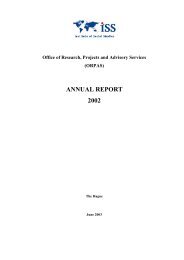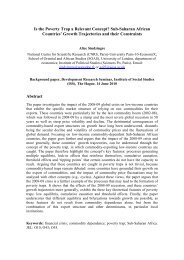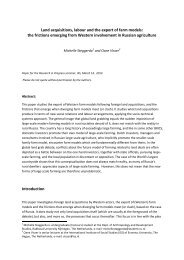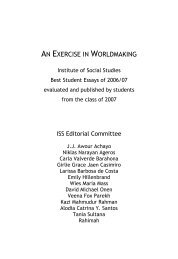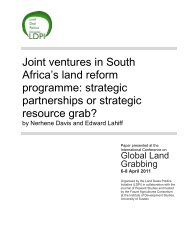AN EXERCISE IN WORLDMAKING 2009 - ISS
AN EXERCISE IN WORLDMAKING 2009 - ISS
AN EXERCISE IN WORLDMAKING 2009 - ISS
Create successful ePaper yourself
Turn your PDF publications into a flip-book with our unique Google optimized e-Paper software.
104 BERNICE CAMPOS ROLD<strong>AN</strong><br />
just in accumulating cash but also in collectivizing people in low-income<br />
settlements:<br />
Once a community-based savings and loans group generates, spends<br />
and manages funds, it develops the capacity to articulate its members’<br />
priorities. It learns to negotiate for resources and support… The savings<br />
group also becomes better organized in defending the interests of its<br />
members – as in, for instance, fighting a threat of eviction… In the case<br />
studies from India and South Africa, the savings groups became the engines<br />
of the community organizations and their federations. (Anzorena<br />
et al., 1998: 174)<br />
TARGET<strong>IN</strong>G WOMEN, BUT WHO TAKES THE CREDIT?<br />
Since the 1990s, there has been a rise in targeting, following the general<br />
shift from food price subsidies to credit programs. Coverage has narrowed<br />
from universal benefits to targeted transfers. Devereaux (1999:<br />
61) defines targeting as ‘any mechanism for identifying eligible (“needy”)<br />
individuals and screening out the ineligible (“non-needy”) for purposes<br />
of transferring resources, typically by defining eligibility criteria’. Coverage,<br />
meanwhile, is ‘the proportion of a (total or eligible) population that<br />
is actually reached by an intervention’. Targeting is intended to reduce<br />
the number of the poor and improve the situation of the poorest, and<br />
also ensure the efficiency, sustainability and inclusiveness of the intervention.<br />
It is a mechanism riddled with problems: complex definitions of poverty<br />
entail high costs of assessment, and cut-off points are essentially<br />
subjective. Given the poor’s risk-averse and survivalist attitude, they<br />
would benefit by not revealing their real income, so even detailed targeting<br />
processes can be prone to leakages (defined as transfers to the nonneedy).<br />
There are also trade-offs between diligence and bureaucratic<br />
costs: Devereaux (1999: 69-70) cites the GAPVU case of individual assessment<br />
in Mozambique where administrative and monitoring costs<br />
took up 15 percent of the program budget; estimated losses to ineligible<br />
claimants and corrupt officials was at 50 percent. Finally, there are political<br />
costs: beneficiaries of well-targeted poverty alleviation programs ‘are<br />
often quite weak politically and may lack the clout to sustain the programs...<br />
Benefits meant exclusively for the poor often end up being poor<br />
benefits’ (Sen, 1995: 14, in Devereaux, 1999: 62). Devereaux concludes




